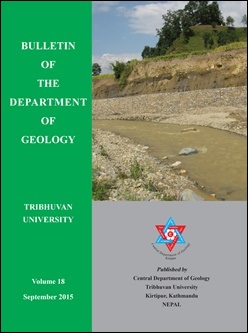Texture and index properties of rocks from Malekhu-Thopal Khola area, Central Nepal Lesser Himalaya
DOI:
https://doi.org/10.3126/bdg.v18i0.16453Keywords:
Texture, grain interlocking, micropetrographic index, index properties, construction materialAbstract
Infrastructures such as road, building, cannals, dam, bridges and so on lie on geological bases. Durability of the structures demands detail study of rocks in microscopic level. Such study helps to give knowledge about strength and physical properties of rocks, and their usefulness as construction materials. Index properties are the basic parameters to be found out before the developent of engineering structures, and are governed by the texture of the rock such as grain interlocking, crystallinity, shape factor, grain size homogeneity, grain orientation, micro fractures, etc.
Textural study of the samples gave the micropetrographic quality index ranging from 0.05 to 49, grain size homogeneity from 0.06 to 0.74, interlocking index ranging from 7 to 92% and texture coefficient ranging from 1.08-1.97. Micropetrographic index has great influence on porosity and point load strength index. Siliceous rocks having high texture coefficient are mechanically sound. When homogeneity in grain size, shape and orientation increases, texture coefficient tends to diminish. Therefore, texture coefficient is an important variable.
Dry density of samples ranges from 2309 to 3224 kg/m3, porosity from 0.08 to 8.91% and point load index from 0.26 to 13.13 MPa. Water Absorption Value (WAV) is entirely below 2% except for the slates indicating that most of the rocks have low effective porosity. Strength of rocks varies from very low to very high. Considering the texture and index properties, the rock types suggested for the construction aggregates are quartzites of the Nourpul Formation, the Fagfog Quartzite, and the Chisapani Quartzite, and psammitic schist of the Robang Formation. The quartzite samples from the Fagfog and the Norpul Formations are useful for silica sources. Siliceous dolomite ‘Np3’ of the Nourpul Formation and dolomite ‘Ml1’ of the Malekhu Limestone also show good interlocking, high density and high strength.
Bulletin of the Department of Geology Vol. 18, 2015, pp. 1–14
Downloads
Downloads
Published
How to Cite
Issue
Section
License
© Central Department of Geology, Tribhuvan University, Nepal

